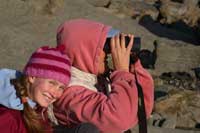 One hundred and eleven years ago, Frank Chapman gave a huge Christmas gift, “For the birds.” How true that was.
One hundred and eleven years ago, Frank Chapman gave a huge Christmas gift, “For the birds.” How true that was.
In 1900, Chapman and the fledgling National Audubon Society decided to organize an alternative Christmas Day activity that focused on observing birds, not shooting them. Tradition “Side Hunts” involved teams bagging game and birds; the biggest pile of fur and feathers won. This wanton destruction of wildlife bothered Chapman and others, so they hatched a conservation alternative.
That first year, 27 people participated in 25 counts across the country. They recorded ninety species during that first “Christmas Bird Census.” Today, the census has molted into the “Christmas Bird Count” or “CBC,” and is held between mid-December and early January. Over 50,000 people will participate in this longest-running citizen science project in the United States. This year marks the count’s 111th anniversary.
Since 1900, counts have sprouted across the United States and other countries. From Coos Bay, Oregon to Cocoa Beach, Florida birders flock to their local CBC. For the 108th CBC, there were over 2000 counts and over 60,000 participants in over 25 countries. The newest continent to host a CBC was Antarctica on Christmas Day 2008. Although they had only 3 participants and recorded just 5 species, they tallied over 270 thousand Adelie penguins.
Although the Moab count will not have penguins, it does have some coveted species like peregrine falcons, merlins, Harris’ sparrows, northern pygmy owls, evening grosbeaks, brown creepers, Lincoln sparrows, great-tailed grackles, and others. “Highlights were eighteen wood ducks, three hooded mergansers, two merlins, one great horned owl, and others,” said compiler Marcy Hafner about the 2009 count. “We also had 47 participants and counted 72 species.”
Generally, the Moab count gets between 65 and 75 species. Numerous factors including weather and coverage affect this total. Though some count days are sunny and cool, I remember one count trudging through a foot of snow in the Matheson Wetlands Preserve.
Hosted by the Moab Bird Club, the CBC is open to all interested parties. Some folks participate by watching their feeders and recording species observed throughout the day. Others join teams that explore assigned areas within the count circle. Fifteen miles in diameter, this circle encompasses the Moab Valley, Matheson Wetlands Preserve, the Colorado River Corridor, Castle Valley, and Sand Flats Recreational Area. Teams drive, hike, bike, float, or sit and record the birds.
Common backyard birds like northern flickers, house finches, house sparrows, dark-eyed juncos, and white-crowned sparrows are usually well represented in neighborhoods.
What the CBC provides is a snapshot of winter birds. Although there is an “expected” assortment of species each winter, because of weather conditions or storms, birders might find some unusual species like gray-crowned rosy finches or red crossbills. These birds are not “expected,” but locating them is a true Christmas gift.
Moab’s CBC will take place on Saturday, December 18. A potluck brunch will follow on Sunday, December 19, starting at 10 a.m. at The Nature Conservancy office on Kane Creek Boulevard. Contact Marcy Hafner at marcymoab@yahoo.com for more information or to participate in the count..